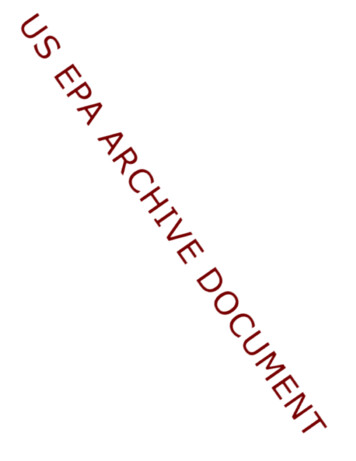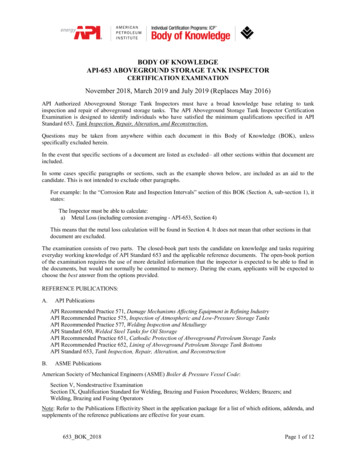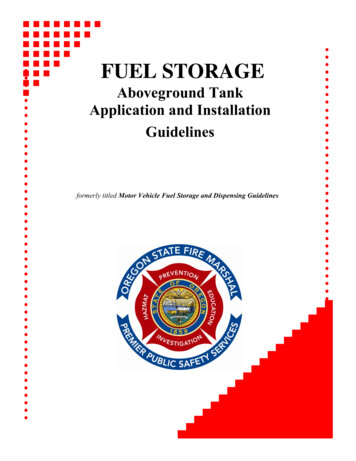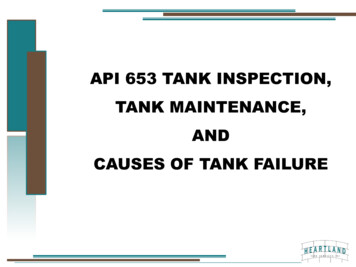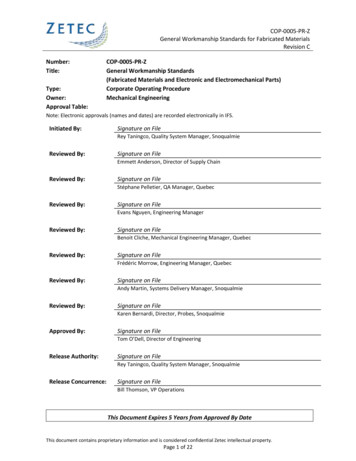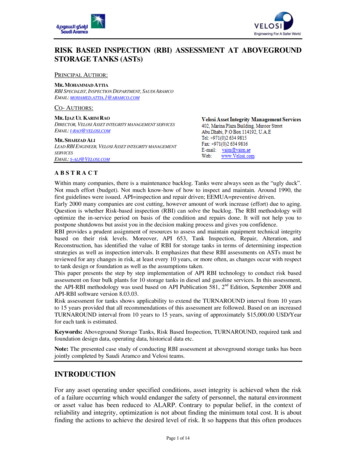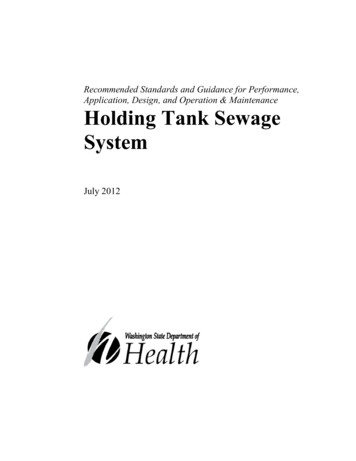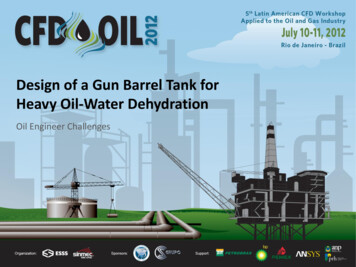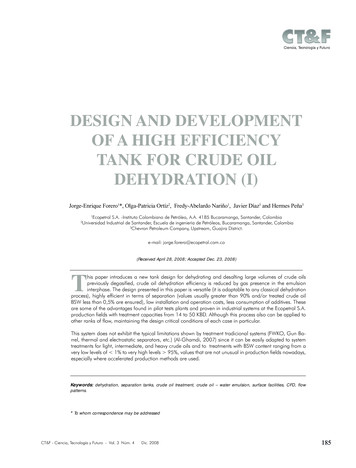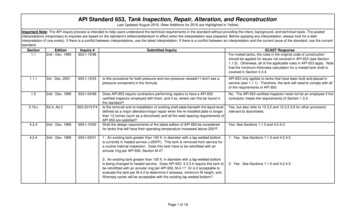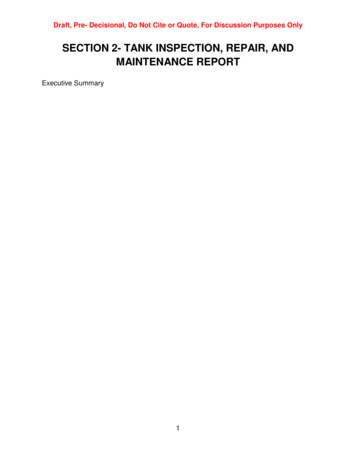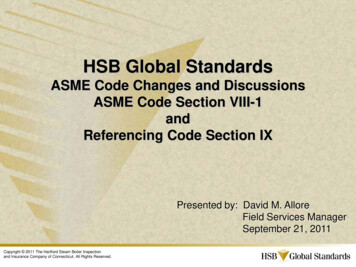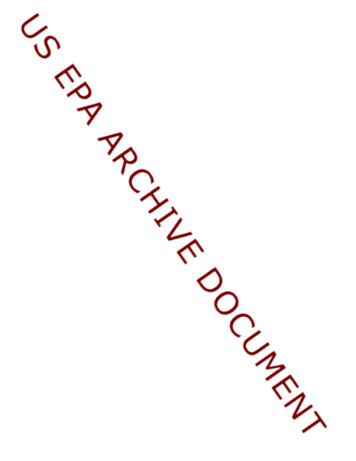
Transcription
Shop FabricatedAboveground TankConstruction StandardsWayne GeyerSteel Tank InstituteFourth Biennial Freshwater Spills Symposium 2002March 19-12, 2002Cleveland, OH
Shop Fabricated Aboveground Tank Construction StandardsOne key to clean freshwater is to prevent hazardous liquid spills from taking placein the first place. An important element to spill prevention is the safe storage ofhazardous liquids in tanks that comply with national standards.Tanks come in many shapes and forms. Large tanks are erected in the field.Smaller tanks are produced in a factory and shipped to the site for installation. Shopbuilt tanks are made for underground installations and for aboveground installations.Aboveground tanks are either oriented for horizontal or vertical installation, and areproduced in either cylindrical form or rectangular form. The tanks are capable of beingdesigned and fabricated as pressure vessels, but are more typically vented to atmosphere.The tank can have compartments internal to the tank. Tanks are often secondarilycontained. The tank can be insulated for fire safety or temperature control. Corrosionprotection can be given to exterior tank bottoms in contact with soil or to the tank interiorwith special coatings and linings. Some aboveground tanks are even installed in anunderground vault or room, without backfill.This paper presents tank standards covering shop-fabricated aboveground tankconstruction. A shop-fabricated tank is typically 50,000 gallons capacity or less. Thatcapacity translates to a 12’ diameter by 60’ long tank, just small enough to fit on atransport truck and be shipped on a highway. Any truckload wider than 8.5’ requires apermit, and any truckload over 12’ in width requires a special highway escort. Bridgeunderpass limitations, weight restrictions, and tank trailer length capabilities furtherrestrict highway transportation shipments, such that tanks larger than 50,000 gallons are2
more economically erected in the field, rather than at the shop. Most aboveground tanksbuilt to these standards store flammable or combustible liquids at atmospheric pressure,and are 12,000 gallons capacity or smaller. With STI labeled tanks, these smallercapacities constitute 97% of all aboveground storage tanks built to STI specifications.During a recent 12-month time interval, 30% of STI Members alone reported buildingover 20,000 tank units of 1100 gallons or smaller. To store product safely andeffectively, tanks constructed today must meet certain minimum requirements asestablished by fire codes.Third Party Test Laboratory Aboveground Tank StandardsIn 1922, the requirements for aboveground storage tanks were transferred fromthe National Board of Fire Underwriters regulations and published in the First Edition ofUnderwriters Laboratories’ UL 142 standard. The UL 142 standard addressed issuesrelating to leakage, venting, and the ability of the tank to withstand the development ofinternal pressures encountered during leak testing. Later, the standard covered therequirements for steel tank wall thickness, joint construction, fittings and manways.In 1993, the UL 142 standard was significantly expanded. The Seventh Editionincorporated secondary containment tank construction, rectangular tank construction andexpanded support design requirements. Secondary containment tanks could be in theform of a steel dike or in the form of a steel secondary containment tank. Rectangulartank requirements were performance based and included hydrostatic tests and top loadingtests. Rectangular tanks became a desirable option for small tanks, typically less than2000 gallons, as operators liked the accessibility of the flat top to perform operations and3
maintenance without the need for special ladders or catwalks. Integral supports needed tobe constructed in accordance with the standard or subjected to a tank support load test.UL published a separate standard for small home heating oil applications underthe UL 80 standard. The UL 80 standard covers an obround shaped tank construction,typically less than 1100 gallons in capacity. When the standard was first published in1927, tanks of this capacity were considered quite large.Underwriter Laboratories of Canada, ULC, has published standards comparable toUL for use in Canada. ULC standards are considered acceptable for installation in theUnited States by many jurisdictions. The Appendix contains a list of appropriate tankstandards referenced within this paper.Tanks Come Out of the GroundBy 1990, as society became more aware of the hazards with non-EPA regulatorycompliant underground storage tanks, tank owners also became aware of the great costsinvolved in cleaning up sites underground to meet environmental regulations. The 1988EPA underground tank regulation targeted the older tank sites, forcing owners toupgrade, remove, replace or completely close tanks that did not meet regulatoryrequirements before the December 1998 regulatory deadline. As result, the number ofregulated underground storage tanks decreased from more than two million to less than700,000 tanks between 1988 and 2000. Where did all of our storage capacity go?In 1988, many underground tanks were old and seldom used. Most of these tankswere removed and not replaced. Some tank owners simply began using their localservice station for motor vehicle fueling needs rather than self-store their fuel. Also, assmall “Mom and Pop” gas stations were shut down, large convenient service stations took4
their place, and that necessitated considerably larger tank capacities. Manyowner/operators began to install their tanks aboveground instead of underground. Thistrend became quite noticeable after 1990, as AST production doubled or tripled. Tankbuyers found greater peace of mind with AST’s – due to the perception of fewerregulations, and the comforting ability to visually inspect the tank for leaks.Fire Code Jurisdiction with Aboveground Storage TanksEPA’s underground tank rule did not extend to aboveground storage tanks. Dueto the manner in which aboveground storage tank legislation was promulgated in 1972for protection of surface waters from oil pollution, state environmental agencies did notreceive similar jurisdiction as they did within the recent underground storage tanks rules.Nonetheless, many states are presently regulating aboveground storage tanks throughother means, and federal tank inspections continue to assure compliance with minimumfederal Environmental Protection Agency aboveground storage tanks requirements.Since many of these tanks were storing flammable and combustible liquids, firesafety codes served as the predominant regulatory documents dictating requirements foraboveground storage tanks, AST’s. But fire marshals were not prepared. The mostcommon new use for aboveground tank installation was for motor vehicle fueling at aprivate fleet fueling facility. In some parts of the country, aboveground tanks were beinginstalled at service stations, but with complete disregard for the fire codes, whichgenerally prohibited such installations.The 1990’s saw a tremendous level of activity in the fire codes. New languagewas adopted in the codes to allow aboveground storage tank installations, with improvedsafety features built in. The goal was to prevent releases from taking place so that fire5
hazards were not created and the associated environmental damage would not occur.This included the use of secondary containment, insulated/protected tank construction,overfill prevention, thermal expansion and anti-siphon devices, and special emergencyvents.One of the more significant changes that took place in the mid-1990’s was withthe spill control requirements of the fire codes. The codes adopted secondarycontainment tanks, up to 12,000 gallons in capacity, as an equivalent to traditionalconcrete dike installations.The culmination of this effort was with the expansion on requirements foraboveground tanks storing flammable and combustible liquids within several fire codes.Principal codes offering jurisdiction of tanks includes: NFPA 30A, Code for Motor Fuel Dispensing Facilities and Repair Garages, Uniform Fire Code, International Fire Code, as supported by BOCA, SBCCI, and ICBO, and National Fire Code of CanadaIn order to demonstrate compliance with the new requirements of the Codes, tankmanufacturers needed recognized listings, and third party test laboratories needed todevelop new tank test standards. Underwriters Laboratories developed UL 2085 forprotected tank construction, UL 2080 for fire resistant tank construction, UL 2244 forAST system construction, and UL 2245 for vaulted construction (to hold an AST in abelow grade room). Southwest Research Institute developed similar third party testlaboratory standards, including SwRI 93-01 for protected tank construction and SwRI 9704 for fire resistant tank construction.6
The protected tank is referenced in all three American codes and represents amajor change in tank construction. The protected tank must be insulated to withstand a2000 degree two hour pool fire environment exposure without leakage and with a limitedtemperature rise, necessitating insulation around the tank. All tanks must incorporatesecondary containment and are normally qualified against impact by vehicles andballistics resistance.New Industry StandardsIndustry trade groups like Petroleum Equipment Institute, American PetroleumInstitute, and Steel Tank Institute also responded to the new demand for abovegroundtanks by developing additional tank construction, installation, and maintenance standardsto address the rapidly popular aboveground tank market and the new safety concernscreated by their popularity.One widely acclaimed publication for proper shop fabricated tank installationswas PEI’s RP 200, Recommended Practices for Installation of Aboveground StorageSystems for Motor Vehicle Fueling.Environmental Rules for Aboveground Storage TanksAs aboveground storage tanks became more prevalent, environmental safetyawareness of our groundwater resources, once focused primarily on underground storagetanks, began drifting towards aboveground tanks. By 2000, Minnesota, Florida,Wisconsin, California, Oklahoma, Missouri, New Mexico, Michigan, and other stateseither had adopted or were in process of adopting new regulations for abovegroundstorage tanks. Several times throughout the 1990’s, the Environmental ProtectionAgency proposed revisions to their Spill Prevention Control and Countermeasure, SPCC,7
regulation (as part of the 1972 Amendment to the Federal Water Pollution Control Act,currently known as the Clean Water Act) and these nearly became officially promulgatedas the Clinton administration concluded their reign in 2001. The SPCC rule requires atank owner to have a plan prepared by a professional engineer to prevent and control oilfrom spilling into surface waters.The first revision to the SPCC rule proposed in 1991 was to require secondarycontainment that was impermeable for at least 72 hours after a release occurred. Thiscreated a whole new movement towards secondary contained AST’s. No longer focusingmost of its efforts on underground tanks and on releases to surface waters fromaboveground tanks, the environmental community further investigated concerns fromaboveground tank system releases that could permeate through soil into groundwater andthen eventually pollute surface waters. Steel became a popular option for secondarycontainment of factory built aboveground tanks due to its non-permeable nature.The initial tank industry solution was to install a single wall aboveground tankinto a steel dike. While this design could contain a release, rain could also collect in thedike and, if contaminated, had to be disposed of as a hazardous material. Somanufacturers began to provide rain shields over the dike opening or completely over thetank. In order to prevent spills during fill operations from being diverted over the rainshield and onto the ground, overfill limiting valves were introduced for pressurized fillingoperations. The valves shut-off delivered flow into the tank at a specific pre-set level ortank capacity.8
First National Construction Standard for Secondary Containment TanksTank owners quickly realized that a double-wall steel aboveground tank, similarin construction to the double-wall steel underground tank, could fulfill the same functionas a diked AST with rain shield. Soon, the double-wall aboveground tank becameavailable in both horizontal and vertical construction as a popular installation option.Secondary containment tanks first appeared in the United States in the early1980’s, when local and state jurisdictions were just beginning to investigate tank leakageand promulgate rules for hazardous wastes and chemical storage. In 1984, Steel TankInstitute (STI) introduced the first national construction standard for undergroundsecondary containment tanks. It provided a design for a Type I, intimate wrap, steelsecondary containment tank, with several alternative construction methods for enablingthe interstice to be monitored for releases (i.e., liquid or pressure sensors, gauge stick,etc.). The STI standard was based on German technology, which had already been inplace for a number of years. The aboveground secondary containment tanks paralleledthis intimate wrap construction method. However, emergency vents were required for theinterstitial space with the aboveground tanks. By the year 2000, secondary containmenthad established itself as one of the solutions to the developing concerns of abovegroundstorage tank releases.STI AST Construction StandardsSTI responded to the needs of the industry to standardize construction bydeveloping the diked AST F911 standard in 1991 (qualifies under UL 142), the doublewall AST F921 standard in 1992 (qualifies under UL 142), the Fireguard fire-protectedstandard in 1994 (qualifies under UL 2085), and the Flameshield fire-resistant tank9
standard in 1
The UL 142 standard addressed issues relating to leakage, venting, and the ability of the tank to withstand the development of internal pressures encountered during leak testing. Later, the standard covered the requirements for steel tank wall thickness, joint construction, fittings and manways. In 1993, the UL 142 standard was significantly expanded. The Seventh Edition incorporated secondary .File Size: 227KBPage Count: 16
